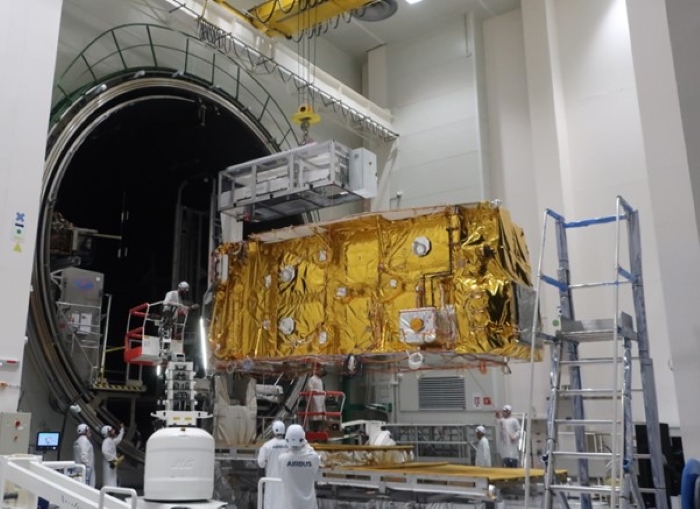Integrations made through European Space Agency's Pacis 3 project moves Spainsat NG closer to launch pad

The European Space Agency's (ESA) Pacis 3 project took another step towards the launch pad, with the Direct Radiating Array Transmit (DRA TX) antenna and associated power supply unit and antenna control electronics recently delivered to Airbus Toulouse. These components were integrated on to the Spainsat NG1 satellite, a crucial element of the Spainsat second-generation programme for Spanish satellite operator Hisdesat.
The successful integration follows the completion of the Thermal Vacuum phase in Madrid in February 2024. The DRA TX underwent its radiated radio frequency test campaign at Airbus Toulouse and was delivered for satellite integration on 20 April 2024, with the preparations for the thermal vacuum campaign now underway.
Installed on the spacecraft, the DRA TX is now following the integration onto the satellite’s distributed electronics units which includes the antenna control electronics and the power supply unit developed by Airbus CRISA. The DRA TX is set to be powered on for the first time in its final flight configuration on 14 June 2024.
The SpainsatNG1 satellite is being developed to provide secure communications for governmental users in Europe in Geostationary orbit. It is equipped with advanced telecommunications capabilities, including X-band and Ka-band services, which are used for secure communications in Spain. The satellite also features state-of-the-art technology, such as Direct Radiating Array (DRA) antennas, which enhance coverage, capacity, and flexibility.
The DRA receive antenna (DRA RX) and Ka-band pallet antennas will be delivered to the satellite later this year, with the antennas due to be delivered for early summer with integration at the end of the month, once the thermal vacuum activities are completed, and the DRA RX is due for delivery between September and October. Once all components are delivered and integrated the satellite will be ready to enter its mechanical test phase, a pivotal step to ensure the satellite’s resilience and operational readiness, then moving onto final preparations before launch, scheduled for the end of 2024.
ESA’s Pacis 3 project has been a collaborative effort between ESA and Hisdesat, supported by the Spanish Space Agency to develop and fly these innovative antenna elements on the Spainsat NG1 satellite. These antennas, developed by an Airbus-led Spanish consortium of six Spanish companies, will be demonstrated through the satellite in-orbit by 2025 featuring in-orbit reconfiguration, beam hopping and geolocation capabilities.
“The Pacis 3 project has demonstrated a true partnership between ESA, Spanish industry and the Spanish Space Agency, coming together to deliver technological advancements that Spain and Europe can be proud of,” said Oscar Del Rio Herrero, ESA’s Pacis 3 Project Manager. “It is great to see, as we move closer to the launch pad of Spainsat NG1, that all the elements our teams have worked so hard on, are coming together.”
“Delivering the first active antenna for Hisdesat's Spainsat NG-I satellite is a remarkable achievement. We are honored to play a key role in this pioneering venture and we look forward the continued success of the Spainsat NG initiative," said Jean-Philippe Delapierre, Airbus Defence and Space Project Manager for Spainsat.
"The integration of this state-of-the-art antenna, featuring in-orbit reconfiguration capability and a versatile X-band payload, highlights our dedication to driving innovative progress in the GEO satcom market for secure communications," said Basilio Garrido, Hisdesat Project Manager for Spainsat.
Discover more about ESA’s Partnership Projects programme and how we’re working across Europe and Canada to develop, de-risk and empower industry and Member States to build innovative space technologies.


